Document approval and signing in EOS for SharePoint
Hello, Habr! Today we want to talk about decision-making - but in the psychological sense, but in the most practical, bureaucratic sense. We think that everyone who worked in a company with more than 20 employees is familiar with the pitfalls of making decisions in them. Psychology is powerless here: the larger the organization, the stronger the terms for joint decision-making in it depend on internal regulations, the number of decision-makers, the speed of their reaction and the degree of automation of the process. In this post we want to talk about how the function of approval and signing of electronic documents in our EOS for SharePoint electronic document management system (EDMS) is arranged : to whom it is oriented, what it is and how it is configured. The coordination chain should not resemble a maze without exit

The function of coordination and signing documents allows you to coordinate any type of text, tabular, graphic, and, upon request, audio materials along a pre-configured decision-making route. EOS for SharePoint 2013 automates the work with documents, allowing you to create them, including templates (the templates for the contract, invoice, order, memo, outgoing letters are already available in the box), jointly edit without forwarding, discuss, approve, sign a qualified electronic digital signature (EDS), send it to contractors by e-mail, post it on the internal corporate portal - and all this using the SharePoint 2013 platform, with the ability to integrate with 1C, CMS, ERP and other software.
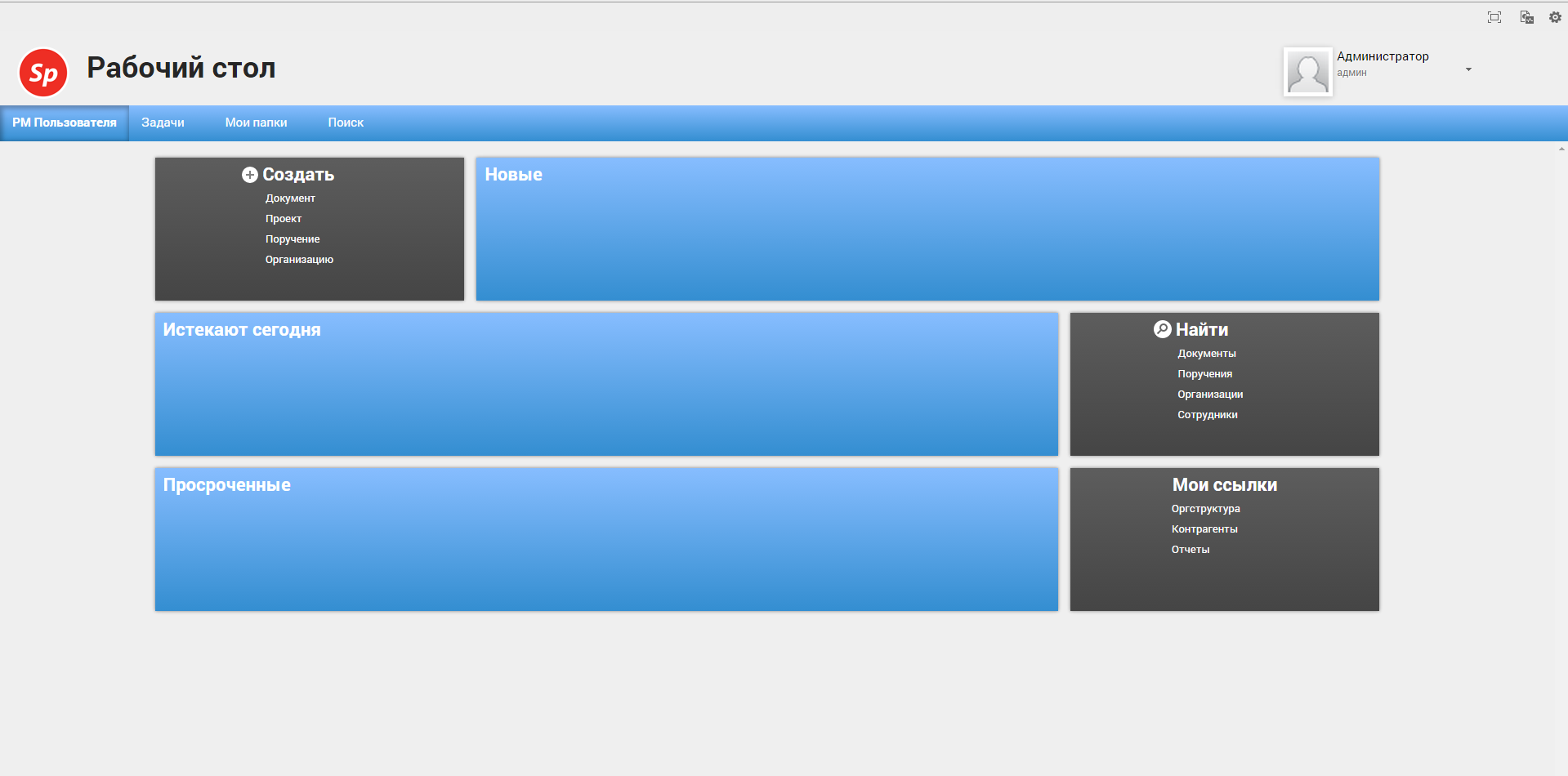
The signing of documents in the EOS for SharePoint 2013 EDMS from the point of view of the user who created the document is as follows:
The participant in the approval process, responsible for one of its stages, receives notifications by mail, in the tray and in the "New" block of the desktop in the EDMS. When switching to the document project, the user sees those tabs and fields that he is allowed to see with the workflow settings. The negotiator can read the document and perform the actions permitted to him, and is also obliged to fill out the fields required from him at this stage and put a matching signature, choosing one of the options: agree, agree with the comments, disagree, reassign the issue or reassign. When you select each of the options, the fields required by the workflow are activated, for example, a comment field or entering the contract amount. In the case of reassignment, that is, delegation of the coordination task, the field for selecting an employee, entering a comment, and the option to select the following actions appear: return for verification or proceed to the next step without verification by the delegating person. Like any coordination action, the delegation process and its attributes are entered into the approval logbook, which any of the process participants can familiarize themselves with.
The values of the approving signature differ depending on the type of stage, for example, for the “Approval” task, the selection options will be different, namely: approved, rejected, out of my competence and reassigned.
After the draft document has changed its status to "Approved", it goes to automatic registration (you can also manually), while changing the number, that is, the document changes from the project status to registered status, new sub-tabs appear (it is configured), and sub-tab “Files” the approved version of the document is rendered.
Video version of the review:
The same thing happens in applications: on the iPad and Windows-tablets, and very soon on Android (follow our blog announcements).
Thank you for reading, we are waiting for your comments.


The function of coordination and signing documents allows you to coordinate any type of text, tabular, graphic, and, upon request, audio materials along a pre-configured decision-making route. EOS for SharePoint 2013 automates the work with documents, allowing you to create them, including templates (the templates for the contract, invoice, order, memo, outgoing letters are already available in the box), jointly edit without forwarding, discuss, approve, sign a qualified electronic digital signature (EDS), send it to contractors by e-mail, post it on the internal corporate portal - and all this using the SharePoint 2013 platform, with the ability to integrate with 1C, CMS, ERP and other software.

The process of approving and signing electronic documents in EOS for SharePoint 2013
The signing of documents in the EOS for SharePoint 2013 EDMS from the point of view of the user who created the document is as follows:
- Authorization on the RM, after which the main blocks of the necessary information are available on the dashboard (configurable), in particular the ability to create a draft document.
- When you activate the latter, a draft document card opens with the ability to select groups of documents available by rights (for example, outgoing letters, orders for core activities, payment invoices, delivery contracts, etc., depending on the settings), select the one you need.
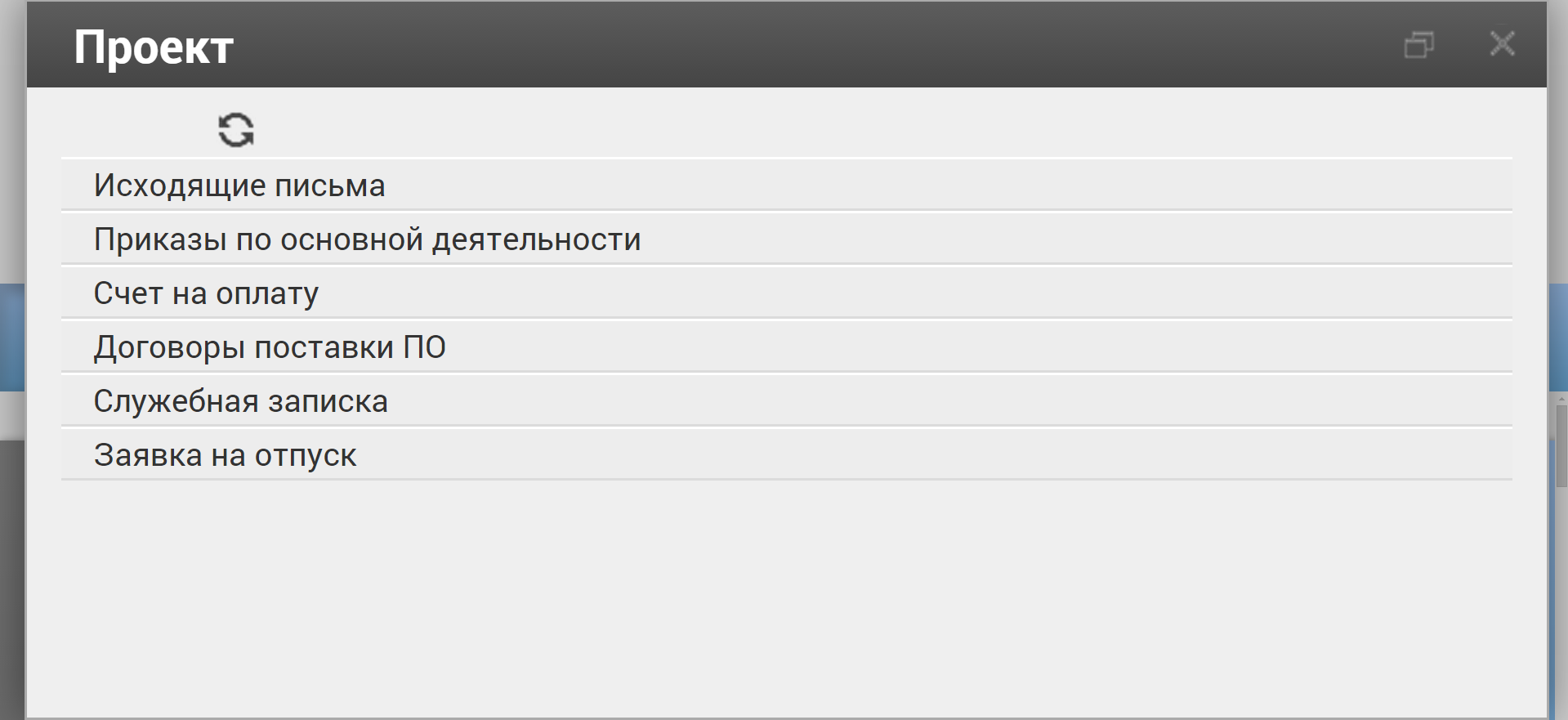
- We fill in the fields of the document card (the fields are also pre-configured for the group of the document), for example, this is: project date, type of contract (with a pre-configured option), the subject of the contract, content, correspondent (organization and name) with the ability to select from the directory (if the company / person entered) by entering the first letters or by creating a new counterparty / contact person card, case nomenclature (selection from the case directory, the possibility of creation). Save.
The numbering of the draft document occurs automatically and can be cross-cutting, for example, the assignment of different prefixes for different groups of documents. You, as a system technologist, can organize auto-completion of fields, indicate the mandatory completion of fields.
- A finished draft of the document opens, on which the user can use the ribbon to perform a series of actions on the tab with the same name, namely:
- change, delete
- put in a personal folder,
- set up notifications
- forward to users (as such, the transfer does not occur, the recipient - the account owner receives a notification on the EDS desktop in the "New" block) and by e-mail,
- send (this is sending to e-mail, for example, to an external recipient, when activated, pop-up opens with pre-configured fields, automatically sets the subject of the letter - for example, the name of the contract, its number and date, the ability to include document card fields),
- set up workflows (more on that below),
- issuance of additional permits,
- export to Excel,
- print out.
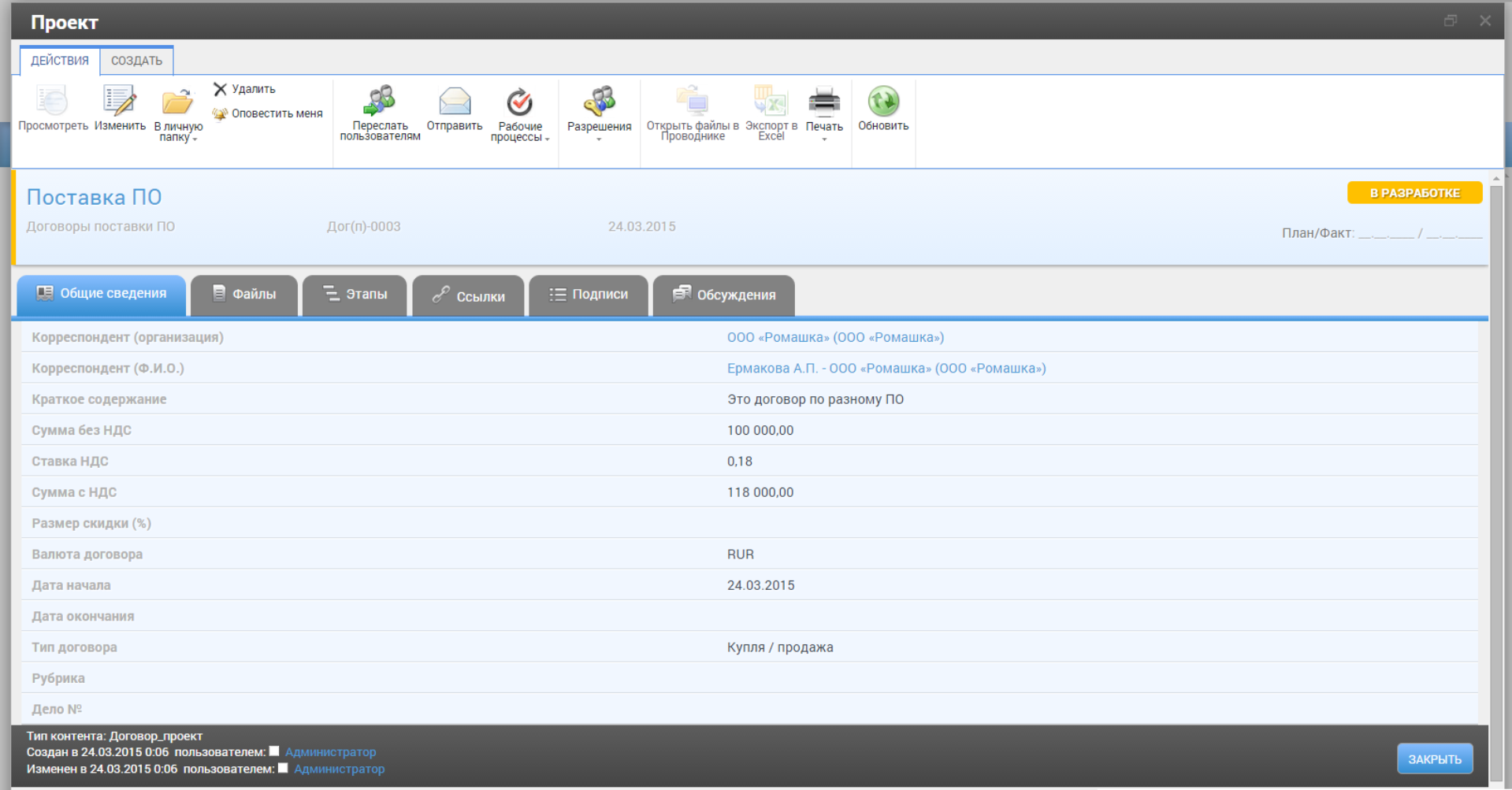
Below, the main block contains custom sub-tabs conveniently placed in a row under the main line of information about the draft document containing its name, date of planned and actual approval and current automatically updated status: in development / under approval / approved. By default, the following sub-settings are pre-configured in the box:- general information (that is, what the initiating user entered in the third step),
- files (here after creation - about it below) all files of the document project are loaded with the name of the file, creation time, author, version of the file, its size and the presence / absence of EDS; thus, any change-saving of the document by the approval parties is numbered by the corresponding version) ,
- stages (used to track the stages of the execution of documents, for example, closing acts, paying bills),
- links (all links to other documents are displayed here),
- signatures (the tab is responsible for displaying the approval procedure, at any time, the initiator of the draft agreement can see at what stage the approval of the document is, which process persons have already completed their project tasks and which are not yet; upon approval by the participants, the Journal is formed here Approval ”, when you click on“ Print ”->“ Approval sheet ”you get a paper copy in a pre-configured design),
- discussion (here you can see all the comments left by the executors of the draft agreement in the process of its approval).
- Add files - directly documents for approval - in the "Create" tab, you can use drag-and-drop. The adjacent Create File button generates a document based on the template specified for this group of documents, substituting data from the Directory for the counterparty selected by the user in step 3. Here, the user can:
- add task steps for the document,
- to connect the document with another, for example, to indicate subordination (coordination of additional agreements to the main contract),
- print magazines by documents.
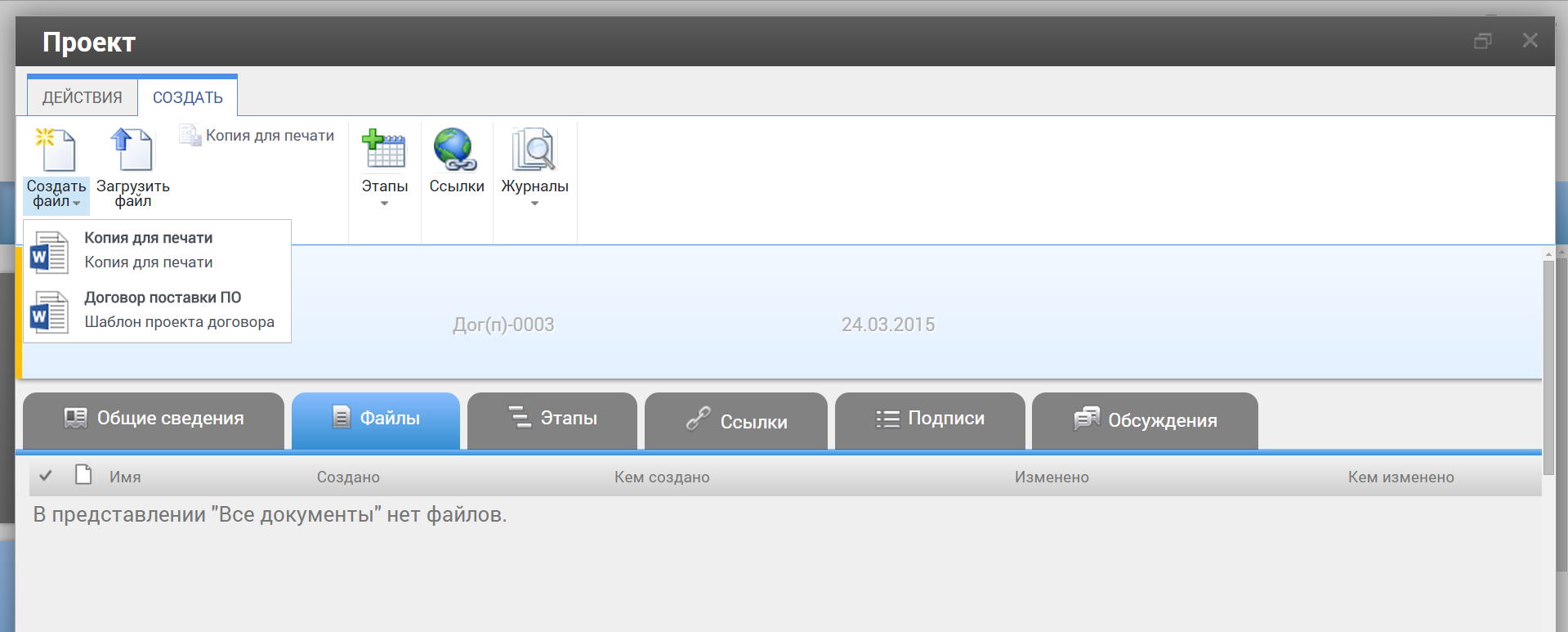
And on the “ EDS and Encryption ” tab , anyone who has the opportunity can sign a document with a qualified EDS or encrypt it to protect data. Each participant can check the digital signature by clicking on the item of the same name on this tab. - Configure workflow settings. Flexible routing settings (“Workflow Parameters”) of the document approval procedure allow you to set any rules. By default, five stages of approval are available: preparation of the project, reviewing, certification, approval, approval - you can add, modify or delete part of them. You will be asked to choose:
- type of stage: internal or external, type of participants: users or groups, roles from the document, roles from the organizational structure (department / employee / managers) or roles from the “help field” of the document;
- options available to performers at this stage of approval: creating new revisions, permission to edit files, writing a signature to the journal, automatic execution of tasks after a deadline, EDS requirement, comment requirement if the result is negative;
- stage duration for each participant;
- the order of tasks at the stage (if there are several participants - parallel or sequential coordination);
- conditions for the interruption of the process (that is, conditions for returning to the author for revision): without interruption, if 1 participant rejects the task, everyone rejects or if one rejects, wait for a solution from everyone;
- transition at the end of the stage: with a positive and negative result, with the possibility of looping the process.
In addition, in setting up the workflow parameters by agreement, you can:- specify an unlimited number of additional conditions using the operators “and”, “or”. For example, you can set the configuration so that when the contract amount is up to 1 million rubles. - the chief accountant participated in the coordination, and over - com. Director
- ask the participants in the stage to fill out certain fields or start a third-party workflow.
The listed settings are available for each stage of coordination. There can be several similar stages.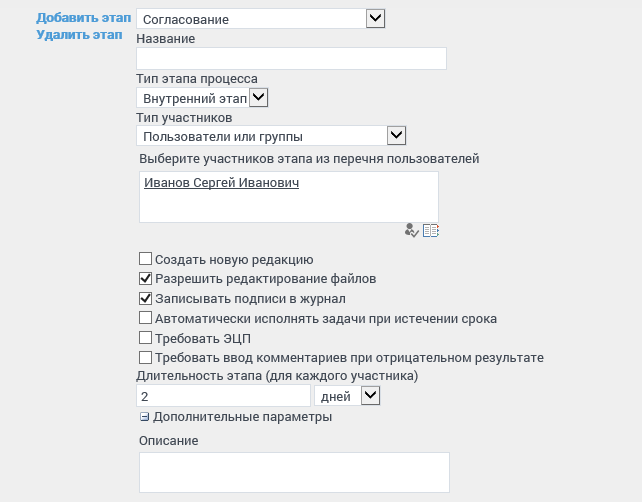

What, in turn, do the participants in the approval process see?
The participant in the approval process, responsible for one of its stages, receives notifications by mail, in the tray and in the "New" block of the desktop in the EDMS. When switching to the document project, the user sees those tabs and fields that he is allowed to see with the workflow settings. The negotiator can read the document and perform the actions permitted to him, and is also obliged to fill out the fields required from him at this stage and put a matching signature, choosing one of the options: agree, agree with the comments, disagree, reassign the issue or reassign. When you select each of the options, the fields required by the workflow are activated, for example, a comment field or entering the contract amount. In the case of reassignment, that is, delegation of the coordination task, the field for selecting an employee, entering a comment, and the option to select the following actions appear: return for verification or proceed to the next step without verification by the delegating person. Like any coordination action, the delegation process and its attributes are entered into the approval logbook, which any of the process participants can familiarize themselves with.
The values of the approving signature differ depending on the type of stage, for example, for the “Approval” task, the selection options will be different, namely: approved, rejected, out of my competence and reassigned.
After the draft document has changed its status to "Approved", it goes to automatic registration (you can also manually), while changing the number, that is, the document changes from the project status to registered status, new sub-tabs appear (it is configured), and sub-tab “Files” the approved version of the document is rendered.
Video version of the review:
The same thing happens in applications: on the iPad and Windows-tablets, and very soon on Android (follow our blog announcements).
Thank you for reading, we are waiting for your comments.

